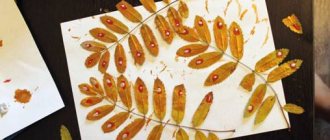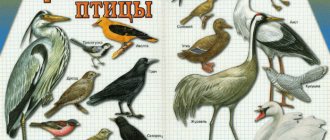Lesson on speech development in the middle group of kindergarten on the topic: Migratory birds
Topic: “Migratory birds.”
Target:
Learn to compose a story - a description and introduce it into a narrative text;
Learn to retell the text, select words - signs and words - actions to the subject; Expansion and activation of the dictionary on the topic: “Birds”; Understand cause and effect relationships in natural phenomena; Develop memory, attention, thinking, apply knowledge in the practice of verbal communication. Equipment:
subject pictures on the topic “Birds”, ball, printout (Vorobyova p. 24)
1.Org. moment: The one who remembers migratory birds will sit down. -What migratory birds live here? -Have you seen birds fly away? Which birds have already flown away? -Why are migratory birds called guests? -Why do rooks arrive first and fly away too? - In the summer he follows the plowman, and in the winter he leaves screaming. What kind of bird is this? (rook).
2. Listen to the story. In autumn, migratory birds fly to warmer regions. There is an empty nest of swallows near our window. No starlings are visible. But the rooks have not yet flown away. In the evenings, they gather in noisy flocks to teach their chicks how to fly. Either the rooks rush in a closed formation, or they scatter in different directions. The polyphonic cry of rooks can be heard far away. They are preparing for a long journey.
3. Conversation. -Where do migratory birds fly away from us? -Which birds have already left their nests? -Which birds have not yet flown away? -How do they get ready for a long journey?
4. “Say otherwise.”
- In autumn, birds fly south (to warmer regions).
- No swallows are visible in the nest (the swallows' nest is empty).
- There are no starlings anywhere (no starlings visible).
- In the evenings, rooks flock (gather) in noisy flocks.
- Rooks quickly fly (rush) in a closed formation.
- Birds rise (soar) high into the sky.
- The birds are getting ready (preparing) for a long journey.
5. Game “Friendly words” - What kind of rooks? (black, smart, cheerful, friendly, helpful, migratory, caring). -What kind of rooks? (black, small, loud, inexperienced)
6. Outdoor game (physical exercise) Children depict how rooks learn to fly: spread their arms to the sides, raise them to shoulder level - inhale through the nose, lower their arms - exhale. The rooks flew high into the sky - they made frequent movements with their arms, raising their arms up; fell down - they “throw” their arms, sharply lower them down, and squat.
7. Compiling a story - description about the rook according to plan:
- Who is this?
- Magnitude.
- What is the body covered with and the color of the plumage?
- Bird body parts.
- Family.
- What does it eat?
- What benefits does it bring?
8.Working with printouts (Vorobyova p. 24)
9. Summary of the lesson.
Homework on the topic “Migratory birds”.
1.Parents are recommended to: Introduce children to migratory birds (crane, goose, duck, nightingale, swallow, rook); Explain why they are called migratory, tell where and when they fly away and why (birds fly away not because they are cold in winter, but because they have nothing to eat, because they eat insects or frogs); Pay attention to those birds that stay with us for the winter. 2. Game “They fly away - they don’t fly away” An adult names the bird, and the child answers whether it flies away or not for the winter. 3. Learn or be able to retell the story close to the text. In autumn, migratory birds fly to warmer regions. There is an empty nest of swallows near our window. No starlings are visible. But the rooks have not yet flown away. In the evenings, they gather in noisy flocks to teach their chicks how to fly. Either the rooks rush in a closed formation, or they scatter in different directions. The polyphonic cry of rooks can be heard far away. They are preparing for a long journey. 4.Draw or stick pictures of migratory birds. Write a description for each according to the plan: who is it?, size, color of plumage, body parts, what it eats, what benefits it brings.
Summary of an open lesson in a preparatory speech therapy group on the topic “Migratory Birds”
Goal : generalize children's knowledge about migratory birds.
OO tasks:
NGO “Cognitive Development” Expand and enrich children’s knowledge about migratory birds and their nesting characteristics; develop and consolidate rules of behavior in nature.
NGO “Social and Communicative Development” To develop the ability to work together, to cultivate an attentive and caring attitude towards living things (birds).
OO “Physical Development” Strengthen the ability to act on a signal. Ensure maximum physical activity during educational activities (carrying out actions according to instructions).
OO “Speech Development” Develop coherent speech on the topic, improve sound pronunciation and grammatical structure (inflection, use of prepositional-case forms). Replenish the nominative (names of migratory birds: stork, thrush, lark, swallow, warbler, wagtail, rook, starling, chaffinch, robin, warbler, wheatear) and predicative (sing, fly, curl, hatch, hatch, build, peck) children's vocabulary .
NGO “Artistic and Aesthetic Development” To develop an interest in music in nature through listening to recordings of bird voices.
Preliminary work : conversations showing illustrations of migratory birds and familiarization with the features of their nesting; reading fiction on the topic, becoming familiar with the rules of behavior in nature.
Equipment : recording of birdsong, 2 easels, pointer, ball, diagrams “Change the word”, “Where is the object?”, inscriptions of the names of birds, divided into two parts; signs for physical minutes: “Park”, “Street”, “Birch”, “Glade”, “Fields”; box with branches, leaves, dry grass, straw, stones, feathers, moss, clay.
Progress:
1. Organizational moment.
Children in a circle on the carpet. The sound of birds singing. P.: Guys, what is this? D: The birds are singing. P: Why do they sing? D.: Because spring came, it became warm, and the birds returned to their native lands. P: Right, but why did the birds return now, in the spring? D.: Because insects appear and the birds will have food. P: Guys, what migratory birds do you know? Children's answers. P.: Guys, today Vanya brought an interesting box to kindergarten, let's look into it! Children and their teacher look at the contents of the box. P.: Who will need all this? D.: Birds! P.: That’s right, but we will find out exactly how during our conversation.
2. D/games “Change the word.”
P.: To distribute the contents of the box to the birds, we will practice changing the names of the birds. Children (2-3 people) change the word by case, following the pattern: for example, there is a nightingale, there is no nightingale, I go to the nightingale, I see the nightingale, I think about the nightingale, I admire the nightingale. P.: Well done, let's play again? Children stand in a circle on the carpet. P.: Catch the ball and answer, Answer and don’t yawn! What can a bird do?
3. D/game “What can a bird do?”
D.: flies, sings, howls, hatches, lays, hatches, builds, lines, insulates, pecks, jumps, etc.
4. D/exercise "Where is the bird?"
P.: Let's play with the starling and his house - what is it called? D.: Birdhouse. P.: Name where the starling is relative to the birdhouse, the rook relative to the nest, using our diagram: P.: Are you probably tired? And so everyone stood up! What birds are called the harbingers of spring? D.: Rooks. P.: We turn into rooks and “fly” around the group, reading the signs and listening to my instructions.
5. Phys. just a minute.
There are signs hanging around the group: Park, Street, Birch, Glade, Fields. The teacher guides the children by saying phrases, and the children follow the route and follow the instructions:
- In early spring, the rooks returned to the Park.
- The Street became noisy from the loud cry of the rooks - “rook!, rook!”
- At the top of the Birch, rooks are repairing last year's nests.
- In the spacious Glade, rooks and rooks collect dry grass to line their nests.
- In the plowed fields, rooks collect beetles, larvae, and worms.
P.: We rested, flew around and collected the names of the birds into words.
6. D/exercise “Put the word together.”
Look, on the easels there is the beginning of the word and the end, you collect the parts of the word, and read the name of the bird. Children approach the easels and put the syllables into words: Pe - night, a - ist, ka - menka, shake - tail, mal - new, zhavo - ronok, slav - ka, chill - face, las - dot, squaw - retz. P.: What birds flew to us? Children read the resulting words. P.: It’s time to help the birds, let’s look at the box and give each bird something that will be useful for building a nest.
7. D/game “Who needs a gift?”
Children take out one object each and “distribute” it to the birds, explaining their choice: Stones - to the wheatear, clay - to the swallow, branches - to the stork, feathers - to the warbler, grass, straw - to the lark, warbler, moss - to the chaffinch, leaves - to the starling, robin, wagtail .
8. Results.
The sound of birds singing. Children are sitting on the carpet. P: How joyfully the birds sing! Tell me, what are they happy about? D.: They returned to their nests, they have everything to repair and build their homes. P.: That’s right, the birds thank you, guys, and are always happy to see you in forests, parks, squares, you just need to remember the rules of behavior. Do you know them? D.: You cannot make noise, shout, tear leaves, flowers, break branches, destroy nests, etc. P.: You are right, and our journey with the birds has come to an end, well done!
Ivanova Anna Vladimirovna Teacher-speech therapist, MDOU "Kindergarten No. 176", Yaroslavl


